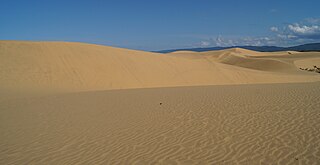
In South America, the word médanos refers to continental dunes whereas dunas refers to dunes of coastal origin. Médanos may be vegetated or unvegetated. For example, the médanos of La Pampa Province in Argentina are mostly vegetated dunes with occasional blowouts. On the other hand, the dunes of Médanos de Coro National Park in Venezuela are mostly unvegetated. An early description of unvegetated médanos in Peru is provided by the Swiss naturalist and explorer Johann Jakob von Tschudi (1847):
"The médanos are hillock-like elevations of sand, some having a firm, others a loose base. The former, which are always crescent-shaped, are from ten to twenty feet high, and have an acute crest. The inner side is perpendicular, and the outer or bow side forms an angle with a steep inclination downward. When driven by violent winds, the médanos pass rapidly over the plains. The smaller and lighter ones move quickly forwards before the larger ones; but the latter soon overtake and crush them, whilst they are themselves shivered by the collision. These medanos assume all sorts of extraordinary figures, and sometimes move along the plain in rows forming most intricate labyrinths, whereby what might otherwise be visible in the distance is withdrawn from the view of the traveller. A plain often appears to be covered with a row of médanos, and some days afterwards it is again restored to its level and uniform aspect. Persons who have the greatest experience of the coast are apt to mistake their way, when they encounter these sandhills."

Procariama is an extinct monotypic genus of phorusrhacid, which lived from the Late Miocene to the Late Pliocene of Argentina. Fossils of the animal have been found in six places, in the Cerro Azul and Andalhuala Formations. More specifically in the Andagalá department and in the north of the Belén department of the Catamarca province, with a single location in the La Pampa province. The type and only species, Procariama simplex, is the largest member of the subfamily Psilopterinae.
Anisia is a genus of flies in the family Tachinidae.
Trypanaresta is a genus of tephritid or fruit flies in the family Tephritidae.

Peter Jörgensen was a Danish early 20th century entomologist, active particularly in Argentina and Paraguay.

Manuel Espinosa was an Argentinian painter.
Palaeomyrmidon is an extinct genus of anteater. Its closest living relative is the silky anteater. Although the silky anteater is arboreal, Palaeomyrmidon lived on the ground. Palaeomyrmidon is known from a fossil skull that was found in the Andalhualá Formation of Argentina.
Neotamandua is an extinct genus of anteaters that lived in the Miocene to Pliocene in South America.
Julio Mario Luqui-Lagleyze is an Argentine historian. Born in Buenos Aires in 1959 received a degree in History in 1982. He specializes in Hispano-American Military and Naval History and Military Museology. He is currently studying for his PhD in History at the Universidad Católica Argentina.

Juan (Jean) Brèthes, also known as Frère Judulien Marie or Juan Brethes was an Argentine scientist, naturalist, entomologist, ornithologist, zoologist and geologist. He was the first entomologist of the National Museum, today known as the Argentine Museum of Natural Sciences. He was a close collaborator of Florentino Ameghino, and translated several of his works into French. Thanks to his intense activity, he systematized a large number of Latin American insect species. He was a precursor in the fight against agricultural pests at a time when insecticides had not been developed to combat them.
Irina Podgorny, Ph.D is an Argentine anthropologist, a historian of science at the National University of La Plata, permanent staff at CONICET, professor ad honorem and Director of the Archive of History and Photographs at the Natural Science Facility and Museum of the National University of La Plata, and winner of the Bernardo Houssay Young Researcher Award. She has held numerous professorships and scholarships and has worked for CONICET since 2013.
Astrophanes is a genus of bee flies.

Julia Wernicke was a painter and engraver from Argentina. She is known as the first animalist painter from Argentina, and was unique at the time in incorporating exotic animals into her paintings. She paved the way for female artists in Argentina through many firsts, especially within the discipline of engraving. Wernicke was one of the first women to have an individual exhibition of works in Buenos Aires, in 1897; and the first person to have an individual exhibition of engraved etchings in Argentina, in 1909.
Trupanea argentina is a species of tephritid or fruit flies in the genus Trupanea of the family Tephritidae.
Trupanea bonariensis is a species of tephritid or fruit flies in the genus Trupanea of the family Tephritidae.
Trupanea patagonica is a species of tephritid or fruit flies in the genus Trupanea of the family Tephritidae.
Trupanea platensis is a species of tephritid or fruit flies in the genus Trupanea of the family Tephritidae.
Trypanaresta ameghinoi is a species of tephritid or fruit flies in the genus Trypanaresta of the family Tephritidae.

Silvia Rivas is an Argentine visual artist known for her multi-channel video installations. In Latin America she is considered a precursor in the area of expanded video. Her work is characterized by the crossing of materialities and technologies in which she uses both electronic devices and ancestral techniques. Her production is organized in thematic series of video installations, drawings, photographs or objects. Interested in revealing the metaphorical power of different materialities, she uses the electronic medium and the moving image to record stillness, the imminent and the subjective perception of time.
Phoenixauchenia is an extinct genus of mammal, belonging to the family Macraucheniidae and the order Litopterna. It lived in Chile during the Miocene.






